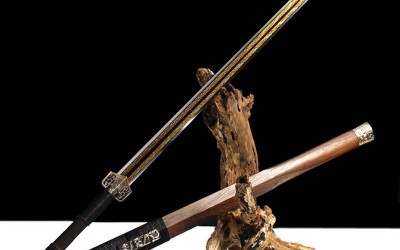Swords Buyer Guide RSS Feed
0
5727
Katana is a generic term for swords forged in the originally developed way in Japan. Japanese samurai swords were worn by warriors of the ruling elite during the middle ages right up to the modern era and acted as much as status symbols as they did w..
0
8320
Tsukamaki means wrapping the handle. It is rewrapping or wrapping new ito on the handle of Japanese hilt. The most common wrapping method is "Tsumamimaki", the ito "pinched" at the crossing, followed by "Hinerimaki", where the ito was folded over twi..
2
91813
Tsukamaki (handle wrapping) is something that anyone can have a try with a little patience. First there is the core of the tsuka, a type of hard wood which is covered with the rayskin (same kawa). The ito is wrapped and twisted around the tsuka. Ito ..
0
19705
The tsuka is the handle of a katana, and it generally has an oval or cylindrical shape. However, there are variations in the shape of the tsuka, depending on the school of sword-making and personal preferences of the swordsmith.There are four basic s..
0
5563
The Sageo (下げ緒) is a cord that extends from the kurikata knob on the saya (scabbard). When the sword is not in use, it is tied in special ways to look presentable. The sageo itself can be made from silk, cord, leather etc. It is generally good form f..
0
7089
The shinogi, is a ridge on the blade that runs from the yokote to the end of the nakago. A blade with a shinogi is then said to be made in the shinogi-zukuri style, which is evolved as the most common Japanese katana blade design, provides both speed..
1
11200
'Niku', which is basically the Japanese word for 'meat' - the meat on the bones of a sword. It is the amount of roundness and curvature of the ji surface, used to describe the tendency of a traditional Japanese blade to have a bulging cross section o..
0
11297
Tachi (Odachi), a Japanese sword with a large curvature, varying body positions to attack and defend. It is popular in medieval to early 16th century Japan. Katana is worn through a sash, usually paired with a shorter blade, with its edge up. The kat..
1
13767
Han Jian, as the name suggests, is a steel sword that flourished in the Han Dynasty (206 B.C.–220 A.D.). As the development of the iron industry in the Han Dynasty broke the limit of the length of the bronze sword, the Han jian was increasingly light..
0
18232
The wood on the outside of Japanese sword tang is called the tsuka, which is used for encircling the blade tang, allowing people to carry the sword conveniently, and it is also a part of samurai sword mountings. From a piece of wood, to the design, a..
1
5574
The Seppa (spacers) are two thin plates that are put on both sides of the Tsuba to ensure the tightness of the mounted pieces of the Katana. In other words it is located on the right and left of the tsuba. The Katana Seppa is considered as important..
1
6595
Habaki, known as blade collar, is a small piece enclosing the base of the sword blade. Amongst several other purposes, it keeps the sword safely in the Saya and locks the Tsuba. The first step in drawing a katana is by grasping the saya and applying ..












